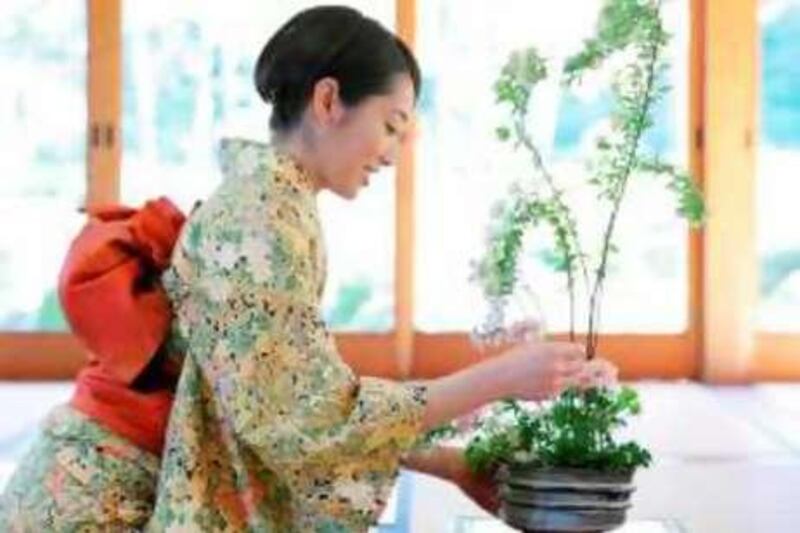It may be famous for its neon lights, dizzying skyscrapers and crowded crossings. But a visit to Tokyo need not be confined to the fast-moving world of the 21st century. Delve beneath the city's sleek and modern surface and a string of traditional Japanese arts, crafts and cultural activities are waiting to be uncovered, from the traditional tea ceremony to calligraphy. Keen to swap conventional tourist attractions with an insight into the mysteries of the Japanese aesthetic, I recently enrolled in a class devoted to ikebana, the exquisite art of arranging Japanese flowers.
Often associated with ladies of leisure and bored housewives, placing pretty flowers in a vase is not generally perceived as the most taxing of pastimes. But in Japan, where the art of flower arranging has been celebrated for more than 600 years, ikebana is taken very seriously. Intrigued by what I could learn with only a bunch of flowers and a vase of water to keep me amused, I made my way to the heartland of ikebana: the Tokyo headquarters of the Ohara School of Ikebana.
Set in the upmarket Aoyama district of Tokyo among architect-designed fashion houses, the school holds weekly classes in English for visiting flower lovers. The neat, bright classroom is filled with rows of desks, each with a perfectly aligned shallow oval ceramic dish, a pair of pliers and a bucket of newspaper wrapped blooms. The room quickly fills up with an eclectic assortment of intrepid holidaymakers from around the world. There is a young bespectacled man and his grey-haired mother from France. A friendly housewife from Norway. A couple of elderly women from Mumbai.
"I have always dreamed of learning flower arranging in Japan," confides Carine, a chic Parisienne in her 30s who is visiting Tokyo on a two-week holiday. "Ikebana arrangements are so beautiful and coming here on holiday is the perfect time to learn a Japanese tradition." My "sensei" (teacher) is Chigusu Fukuda. With her smart houndstooth jacket, tidy bobbed hair and red lipstick, she exudes the authoritative air of a first lady. But she is kind and articulate - as well as an established authority on all things floral, having taken her first ikebana class at the tender age of seven.
As the class gets underway, I learn that Ohara is one of three key schools of ikebana to emerge in Japan. And ikebana is apparently not just about a few pretty flowers in a vase. It is the abstract use of empty spaces and asymmetric forms in order to create a sense of harmony between the flowers, the container and the setting. At least that's the theory. It transpires that the route to floral nirvana is marked with numerous regulations and mathematical formulae that strictly dictate every aspect of the process - from the number of blooms to the length, angle and position of the stems.
Today, we will be entering the labrynthine world of ikebana by creating the Ohara school's signature Moribana arrangement - otherwise known as the Upright Arrangement. Writing on the whiteboard, Fukuda Sensei launches into a complex list of stems divided into primary, secondary and filler categories, each with its requirements. Somewhere between a cross section diagram of the angle of the stem from the base and an aerial view of secondary and filler flowers, I find myself completely lost.
And I'm clearly not alone. "Are you following this?" mouths a confused-looking American man in a checked shirt sitting to my left. But amid the maths there is poetry. "Arrangements are inspired by artworks and you are all artists," exclaims Sensei Fukuda with flourish. "You must paint a picture." I stare in bafflement as I try to imagine transcribing the mathematical conundrum on the board into art. After handing out pretty photographs of what we are aiming to create, she nods her head and we are able to start.
The first snip is the hardest. Having unwrapped three stems of perfect white lilies and three yellow roses, I spend far too long wondering which should be my primary stem - the focal point of the display. After picking at random a tall stem of lilies, I set about measuring it to one and a half the length of the ceramic dish as instructed - which proves trickier than anticipated without a tape measure.
Finally - after much procrastination and sneaky peeping at other students over my shoulder for reassurance - I raise the pliers and make the definitive snip. After sticking the stem gingerly into the metal pin box at the bottom of the dish in a vertical position, I am surprised to see that it stays where I left it - for about five seconds. After struggling repeatedly to stop it from falling over, I survey a more senior student solving the same problem by cutting the base of the stem at a slant. Following her cue, I am relieved to see that my somewhat shortened lily is finally content to stay in position.
The next few hours pass in a floral haze as I snip and stick and measure and calculate. Apart from a minor case of flower envy when I catch sight of a serene middle-aged lady at the next desk creating a perfect swirl of twigs and camellias, the overall effect is pleasantly calming. Waiting for the final inspection from my sensei, I survey my bundle of blooms with pride. My flowers, however, have a surprise in store for me. Clearly failing to comprehend the gravitas of its position, my renegade secondary stem suddenly buckles before flopping over the edge of the dish.
Ten comedy-sketch minutes ensue. Again and again, I stick it back in at the correct angle - 60 degrees from the first bloom and 45 degrees out to the left - only for it to flop back towards gravity. Surrounded by snipped stems and torn leaves, I lay down my pliers in defeat. Fortunately, Fukuda Sensei specialises in emergency floral remedies. Amid a flurry of flower shuffling, trimming and puffing, she says: "It's fine, we can just put this here, move that there and cut this part off here. We can even use glue sometimes to hold things in place."
Stepping back after she has given it a five-minute makeover, I am forced to cast all floral scepticism aside. Like the best of editors and most eagle-eyed of illustrators, she has managed to create something clean and beautiful with the minimum activity. By moving only a few leaves, stems and buds, she has created from my sad looking tangle of blooms a floral nirvana. "Ikebana takes years and years of practice," she smiles. "Once the rules are mastered, then you can be creative."
Clutching my flowers as I head out of the school, I find myself embracing a novel appreciation of all things floral - as well as an unexpected respect for flower-arranging ladies who lunch.





